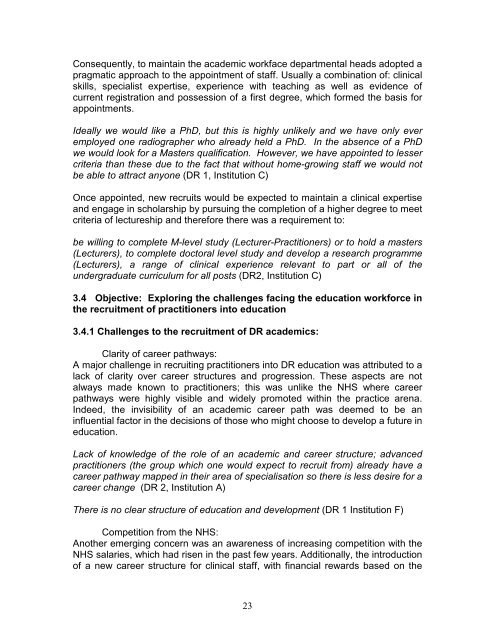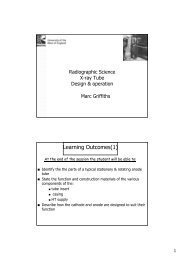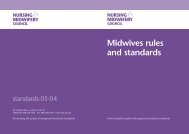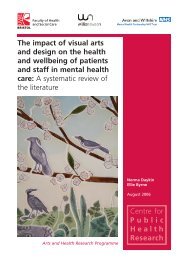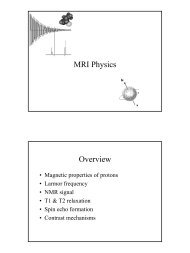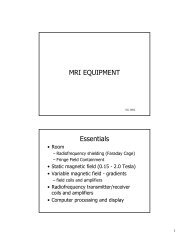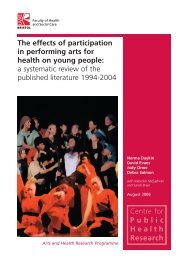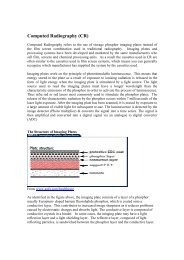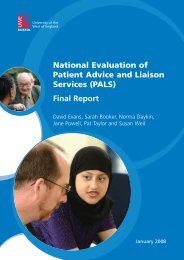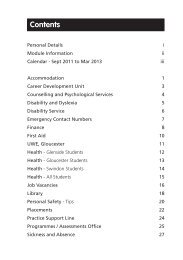Recruitment and retention of diagnostic radiography academics ...
Recruitment and retention of diagnostic radiography academics ...
Recruitment and retention of diagnostic radiography academics ...
- No tags were found...
You also want an ePaper? Increase the reach of your titles
YUMPU automatically turns print PDFs into web optimized ePapers that Google loves.
Consequently, to maintain the academic workface departmental heads adopted apragmatic approach to the appointment <strong>of</strong> staff. Usually a combination <strong>of</strong>: clinicalskills, specialist expertise, experience with teaching as well as evidence <strong>of</strong>current registration <strong>and</strong> possession <strong>of</strong> a first degree, which formed the basis forappointments.Ideally we would like a PhD, but this is highly unlikely <strong>and</strong> we have only everemployed one radiographer who already held a PhD. In the absence <strong>of</strong> a PhDwe would look for a Masters qualification. However, we have appointed to lessercriteria than these due to the fact that without home-growing staff we would notbe able to attract anyone (DR 1, Institution C)Once appointed, new recruits would be expected to maintain a clinical expertise<strong>and</strong> engage in scholarship by pursuing the completion <strong>of</strong> a higher degree to meetcriteria <strong>of</strong> lectureship <strong>and</strong> therefore there was a requirement to:be willing to complete M-level study (Lecturer-Practitioners) or to hold a masters(Lecturers), to complete doctoral level study <strong>and</strong> develop a research programme(Lecturers), a range <strong>of</strong> clinical experience relevant to part or all <strong>of</strong> theundergraduate curriculum for all posts (DR2, Institution C)3.4 Objective: Exploring the challenges facing the education workforce inthe recruitment <strong>of</strong> practitioners into education3.4.1 Challenges to the recruitment <strong>of</strong> DR <strong>academics</strong>:Clarity <strong>of</strong> career pathways:A major challenge in recruiting practitioners into DR education was attributed to alack <strong>of</strong> clarity over career structures <strong>and</strong> progression. These aspects are notalways made known to practitioners; this was unlike the NHS where careerpathways were highly visible <strong>and</strong> widely promoted within the practice arena.Indeed, the invisibility <strong>of</strong> an academic career path was deemed to be aninfluential factor in the decisions <strong>of</strong> those who might choose to develop a future ineducation.Lack <strong>of</strong> knowledge <strong>of</strong> the role <strong>of</strong> an academic <strong>and</strong> career structure; advancedpractitioners (the group which one would expect to recruit from) already have acareer pathway mapped in their area <strong>of</strong> specialisation so there is less desire for acareer change (DR 2, Institution A)There is no clear structure <strong>of</strong> education <strong>and</strong> development (DR 1 Institution F)Competition from the NHS:Another emerging concern was an awareness <strong>of</strong> increasing competition with theNHS salaries, which had risen in the past few years. Additionally, the introduction<strong>of</strong> a new career structure for clinical staff, with financial rewards based on the23


